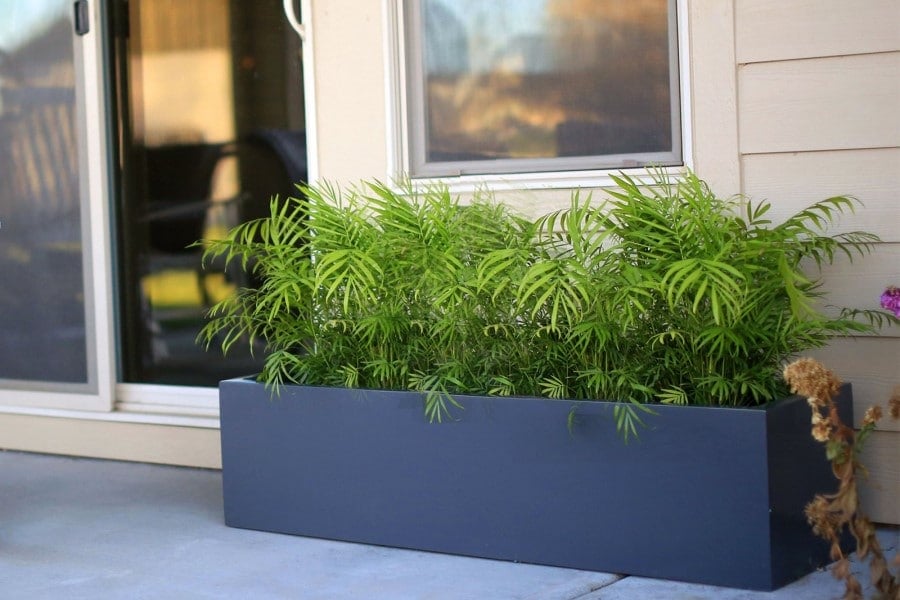If you are looking for a material that will give your planter project some weight, you may have come across both fiberglass and fiberstone.
These materials can be used to create containers of any size and shape for various purposes. However, there are some differences between the two materials that need to be discussed before making a decision about which one you should use.
What is fiberstone?
Fiberstone, also known as fiber stone, is made from a mixture of fiberglass and crushed stone (usually limestone). Sand, metal fiber, and other heavy elements are sometimes added to the mixture to provide weight and strength.

Fiberstone products are more lightweight than natural materials like metal or real stone.
Is fiberstone heavy?
Planters made from fiberstone are strong and lightweight for their size, though large and extra-large planters will be a touch on the heavy side. The exact weight of fiberstone planters will vary depending on how much stone composite the manufacturer chooses to use, but they are guaranteed to be heavier than fiberglass.
What is fiberglass?
In simple terms, fiberglass is made when glass fiber is put under pressure and cast in a mold. It’s a material that can be used to make containers of any size and shape for various purposes. It’s also the same material most cars and boats are made of.
Fiberglass has long been the standard for creating high-quality containers used in any project, from commercial to residential, and indoor or outdoor use.

It’s most commonly used in the production of commercial planters because it is incredibly lightweight compared to natural stone or even to alternative composite materials like fiberstone.
It also offers plenty of durability and strength, making it an ideal choice for large and extra-large planters
What is the difference between fiberstone and fiberglass?
Both materials offer a variety of benefits and drawbacks. The time-tested molding and finishing methods have made fiberglass cheaper to produce and more accessible while offering plenty of durability and strength for larger plants as well.

On the other hand, fiberstone products have some advantages too – such as their ability to withstand extreme weather conditions. Fiber stone pots also offer a look and feel that is already weathered with a rough texture due to the concrete and stone composite inside.
Pros and cons of each material
Advantages of fiberstone
- Fiberstone pots are available in various shapes and sizes, from a few inches to over two feet.
- It is a rigid, durable, and versatile material that is resistant to the extreme outdoors
- Fiber stone has a real stone look and feel. Its appearance can be made to look like concrete too.
- Fiberstone’s natural stone and antique feel suit traditional designs.
- Small fiberstone pots are light enough to be used both indoors and outdoors.
Disadvantages of fiberstone
- Large fiberstone planters can get very heavy and difficult to move around as a lot of their composite is from natural stone.
- Without being able to move large fiberstone pots around easily, it is difficult to bring plants indoors and outdoors as you wish.
- This inflexibility can affect your plants, and make decor arrangements more difficult.
- Fiber stone has a rough and weathered look that won’t suit every customer or design project.

Advantages of fiberglass
- Fiberglass products are very lightweight, which means planters can be moved outdoor to indoor with ease.
- Fiberglass is available in thousands of colors to match any project without difficulty.
- Fiberglass planters are durable and strong enough for outdoor use, even for extra-large plants like palm trees.
- Maintenance is easy and there are many products in the market to touch up little scratches and even fix bigger problems too.
- This versatile product can be shaped into any design, contemporary or ultra-modern.
Disadvantages of fiberglass
- Cheap fiberglass is thin and not so durable. This might not be a problem for the garden hobbyist, but high-quality fiberglass is a thousand times better for more serious projects.
- Extreme weather like below zero temperatures may crack cheap fiberglass over time.
- Fiberglass is more expensive than other materials like concrete and clay, but lasts a lot longer.
- Fiberglass planters look modern and can have a smooth or textured appearance, but will never match up to old metal or ceramic for antique designs.

Final thoughts
In the battle between fiberstone and fiberglass planters, we choose fiberglass. It has been used in a variety of industries and applications over the years because it provides excellent strength while being cost-effective to produce.
It is lightweight enough to allow some flexibility when arranging your garden, and it is strong enough without needing to be reinforced.

Not only that but the smooth appearance, color options to suit any decor, and the fact we can add texture when cast in the mold, makes it the most versatile material known to man. That’s why fiberglass is perfect for any planter project.
Take a look at our project for a client here to find out how we made their dream come true!

Claude Marquise – 301 Ocean, Santa Monica
The client wanted to add privacy to its rooftops, balconies and interior apartments by using the beauty of nature. Learn how our planters were perfect!
View ProjectIf you are looking for your next planter to complete your garden or interior design project, look no further.
Jay Scotts high-quality fiberglass planters have all the strength benefits of fiberstone, while being light enough to move around with ease. If you’re still undecided about which material to choose, take a closer look at why we choose fiberglass.
